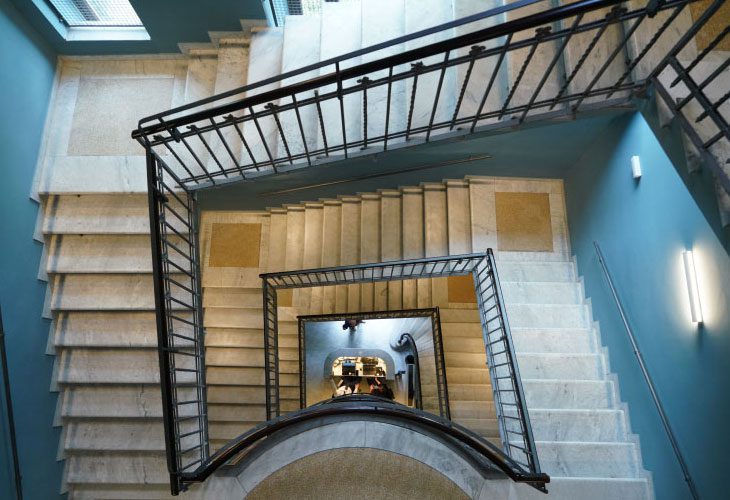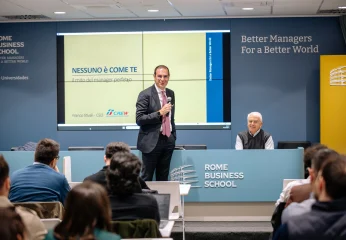The restart of luxury fashion: from the metaverse to sustainability

Fashion, and the luxury sector in particular, was one of the sectors most affected by the impact of Covid-19. This is evidenced by an average drop in turnover of more than 30% in the first half of 2020 compared to revenues in the same period of the previous year, which was also confirmed in the second half of 2020 where turnover fell by around 40%. Apart from the personal care and accessories sector.
This setback has forced the sector’s multinationals, and consequently also the large Italian groups, to rethink their business models in order to adapt to the changing needs of the reference context.
In this scenario, the fashion giants, in order to maintain their competitive advantage, have revolutionised their business strategy also through an acceleration of the digitalisation process that had already been underway for some time, a ‘modernisation’ of their production methods, supply chain and product marketing, with a decisive boost to the online market.
The Trading Up
In addition to this, trading up has been directed towards an emotional involvement of the consumer, especially in the younger target – which accounts for 40% of total expenditure – increasingly conditioned by the symbolic and cultural value framework represented by brands. In fact, the latter’s adherence to social causes, geo-political events and particular sensitivity to production that respects the environment and the different personalities of individuals, represents an important element that can significantly differentiate a brand from its competitors.
To understand how fashion has returned to confront the challenges of the market after the tsunami from Covid 19, we met lecteur of the Master in Fashion and Luxury Managementat Rome Business School Francesca Bracci, who said:
“I like to think that after the tsunami we did not witness a simple restart but a real ‘new beginning’, because all the canons of our life have been redesigned, mixing technology with humanism, just as Brunello Cucinelli pointed out. Luxury in-presence events returned: in NY, London, Paris, Milan, Venice and Rome. At the same time, we have witnessed events in hybrid mode, linked to technology and augmented reality, which ignites creativity and also addresses new communication channels, certainly more inclusive than before.
In fact, since the pandemic, international fashion brands have shared fashion shows and back stages in live streaming on their online platforms, and the Italian Chamber of Fashion has offered the possibility, even to non-specialists, to attend fashion events online and live. This is the social and revolutionary phenomenon of the democratisation of fashion, which pushes brands towards a very strong challenge: to communicate their messages to a planetary audience in a different, more incisive and more topical way. That’s why the values embodied by the brand are now, more than ever, an indispensable plus.“
The Metaverse
During the two-year pandemic many fashion giants have used the web, with existing or ad-hoc created platforms, to maintain a constant relationship with their target audience. It is estimated that by 2024, the volume of luxury fashion business in the metaverse will be close to USD 800 billion.
There are many, however, who believe that the expansion of the digital sphere will not depute the decline of the traditional fashion world, but will result in an exceptional opportunity to make the fashion industry even more universal and contemporary. Thus, young designers or first-time designers will be able to make their creations known independently in the official programmes of events.
“Perhaps it may seem a bit of a paradox the timing in which the virtual reality experience in fashion arrived. In the season when fashion shows are back in presence, the metaverse opens up before our eyes, which presents itself as a parallel, imaginary world. Everything humanistic is abandoned to explore a universe that is completely virtual, with fashion without physical or ‘numerical’ formulas to constrain the imagination. The perspective is broadened: it is inclusive because it has no genre limits and is also sustainable from a production point of view.
What is generated within this world is the experience, the pillar of the new luxury marketing: from the physical one of a store, to the multisensory one of platforms that is liberating, free, light and fluid, therefore absolutely representative of the new generations. This is the greatest challenge for luxury brands: a continuous fine-tuning between identity and brand heritage, with constant adherence to the new, to the social that is changing and moving forward.”
The Flow Power
Fashion has always played an important role in our lives: it has represented the personality of individuals and the cultural evolution of society, becoming a symbolic vehicle and communication tool. Today, more than ever before, it represents a means of social inclusion, in its broadest sense, in a globalised context characterised by a melting pot of cultures, ethnicities, religions, genders and different abilities, abandoning the merely exhibitionist concept of clothing to become a cultural ‘stamp’ of the same, precisely because it is an ‘expression of values’.
From this point of view, fashion represents the new languages that disrupt known paradigms, because fashion takes up society’s impulses and declines them into collective emotions, with the presentation of productions, and individual ones with the choice of products to buy, always in keeping with the new dictates of inclusivity.
“Today, brands are called upon to manage a fluid flow of information with the declared aim of conquering Generation Z, that constantly hyper-connected group of consumers who, compared to other targets, have a very strong and differentiated characteristic: they are not loyal to brands as such but to the values they are capable of expressing and their ability to keep their promises. In a way we are witnessing a reversal of perspective: it is no longer the brands that dictate the pace, but it is the new generations that demand a commitment to humanitarian battles and to celebrating diversity, uniqueness and inclusiveness.
This is why the stars of Instagram, the Tik-Tokers, bloggers, Influencers, sportsmen and women become the protagonists of fashion, because they are able to help management understand what the x factor capable of capturing the attention of young people can be. The new generation of consumers puts sustainability at the centre. The strand of inclusive fashion is born, collections that allow people with different abilities to feel good in the clothes they wear. Beauty care also chooses new testimonials, ambassadors of a natural, unique, organic, in a word holistic, green beauty. A positive beauty philosofy that tells about people without the alteration of digital retouching.“
Sustainability
If in the past prestige, understood as the economic capacity of the consumer, desirability, linked to the uniqueness of the chosen product, and relevance, i.e. the difference from the competition, were the key elements that fixed the value of a luxury brand, today it is sustainability that is the key word that distinguishes markets.
“Sustainability is currently at the centre of any kind of social, political, marketing and communication debate. We have been talking about an approach to sustainability for several years, but only now do politicians, governments, and the world seem to want to overcome years of consumerism and unbridled waste by rethinking business models. It should not matter to us if the path taken has not been spontaneous. Today, those with purchasing power, especially among the young, are careful about what they buy: they have a very strong awareness of how they want to live and the values they want to respect. Today, the recycling of old garments is about giving clothing a second life. Sustainability has become an important focus of choices because it is changing our culture. We have started to be sustainable in small everyday acts: now we have to educate our minds. What we are facing is a long way, but the path has begun and there is no going back.”
The Skills
“Those who want to emerge in the diverse luxury fashion sector must be endowed with a strong creativity and the ability to regenerate themselves, i.e. to transform themselves into something else. Artists, creatives and designers must possess the gift of mental freedom and originality, and management must understand that it would be a mistake to harness their creations in rigid business models.
In addition, one must know the target market and especially the target audience one wants to address to have a competitive advantage.
But it is lifelong learning, continuous training, which allows one to develop transversal mindsets, that is the real driving force. One must observe society, study cultural trends to understand what is happening around us.”
FRANCESCA BRACCI
Graduated in Sociology with a specialisation in Communication and Mass Media at La Sapienza University of Rome, she has over ten years experience in managing VIP relations and organising luxury events in collaboration with leading Italian jewellery and luxury fashion brands for top clients. She has been responsible for organising bespoke luxury events and in-store experiences for members of the Royal Family from Middle Eastern countries and for top clients.Assistant to the President and CEO of a multinational oil company, managed embassies and top management, internal and external communication, travel arrangements. Planning and organisation of exclusive events for top management and visits of Foreign Ministers.
Guest professor and staff trainer for Italian and international institutions in the areas of expertise: fashion and luxury marketing, luxury hospitality, sales strategies and customer experience management, soft skills and communication strategies.




